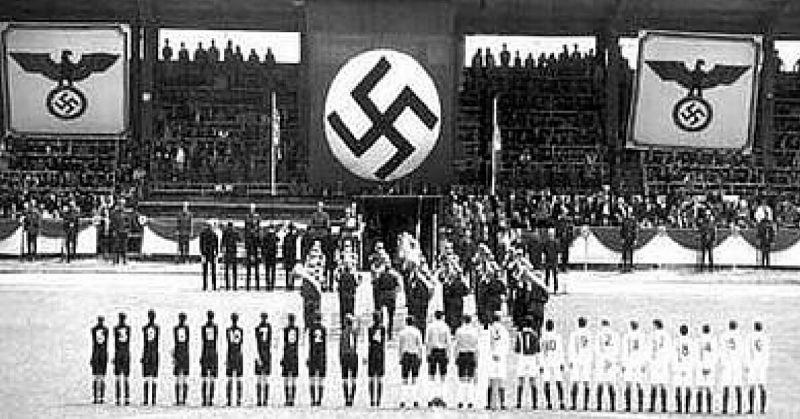Let’s dive into the past when playing football could’ve got you killed. In 1942, in occupied Ukraine, a football match was organized by the Nazi government, between the workers of the Kyiv Bread Factory No. 1, and the German Flakelf, which consisted of soldiers from the anti-aircraft artillery unit.
Football was extremely popular in the Soviet Union in the 1930s, which led to the establishment of the Soviet Top League in 1936. A number of clubs were restructured, and a whole new level of professionalism was bestowed upon the Soviet national league. Dinamo and Lokomotyv, two rival clubs from Kyiv, were both at the top of the charts, Dynamo often coming second to Moscow clubs like Spartak and Moscow’s own Dynamo, which were the best clubs in the Soviet Union at the time.
A peculiar fact is that Dynamo Kyiv, like many of successful football clubs in USSR, was often sponsored by NKVD, whose members took an interest in this sport. The club, therefore, was ideologically marked as communist when the Germans occupied Ukraine and it was immediately disbanded. Many of Dynamo and Lokomotyv players joined the Red Army or the partisan resistance, while the ones who stayed found work in the bakery whose owner was a big fan of Dynamo Kyiv.
As part of the pacification process, Lieutenant General Freidrich Georg Eberhardt of the German Army, who was a great football fan, suggested that matches should be played between the local population and the Axis forces. The bakery owner, having learned of this, sponsored his workers, who were also professional football players, to form a team and apply for the competition.
The team was named FC Start and consisted of ex-footballers from both of Dynamo and Lokomotyv. These men were actual players, opposed to the amateur teams of Hungarian, Romanian and German soldiers who were so sure of their guaranteed victories over the “inferior” Ukrainians.
Before the war they received professional training and even though they were inactive for almost a year, they still knew a thing or two. One of them, Ivan Kuzmenko was famous for using a ball three times heavier than regular for practice. Once on the field, he would literally launch the football thrice as harder, causing the goalkeeper to duck for cover.
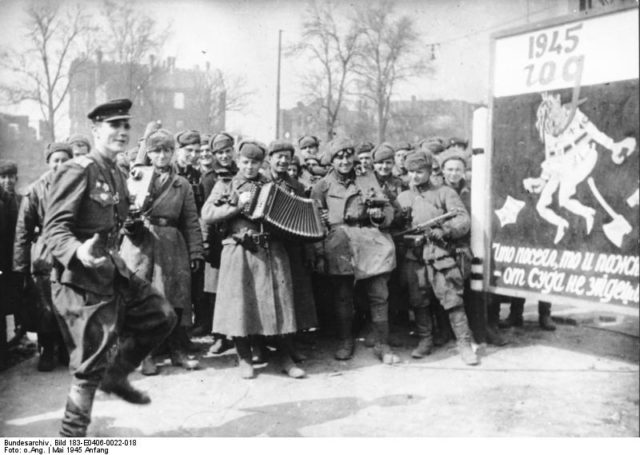
The Germans weren’t well informed on the background of FC Start and with this element of surprise the team stepped on the stage. First, they faced the members of the Hungarian regiment. The result was 6:2 for Start.
Several days later, against the Romanian team, they won 11:0. But they were only warming up. Meanwhile, some local newspapers began to spread the word of a football club that defied the tyrannical occupation forces. Once the Germans realized what they’ve done, they tried to calm down the public and diminish the club’s success.
They started charging tickets for the matches. The price of the ticket was 5 rubles, which in times of crisis wasn’t a small sum. Nevertheless, the crowd kept coming on the Kyiv Zenit Football Stadium on which the games were held. The newspaper coverage was canceled, even though the word still spread around about the unstoppable underdog club.
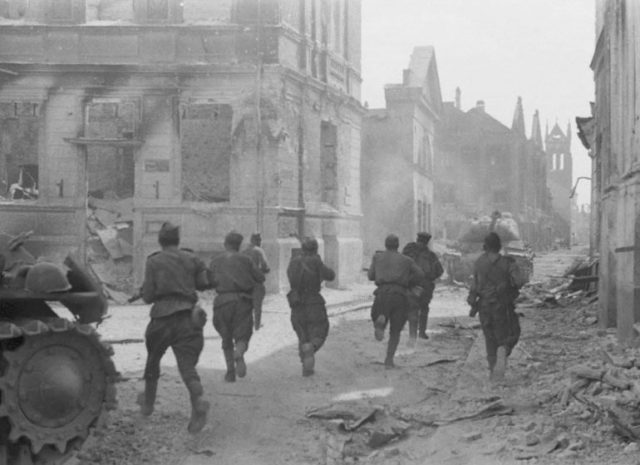
In addition to their victories, the men wore red jerseys, which to some seemed as spite against the Nazis, with the red being the color of communism.
FC Start then defeated a team of German soldiers, with the score 6:0 and another Hungarian team, which was considered far better than the previous, ending with 5 goals against 1. Things became serious ― the Ukrainians didn’t only seem invisible, but they were pulverizing everyone who crossed their path. The Hungarians asked for a rematch, only to lose by one goal, 3:2.
Then the Germans formed Flakelfe ― the official team of the Luftwaffe, consisted only of pure Aryans (by German criteria) who represented the German sports spirit at its highest.
But the ragtag team didn’t care about their opponents. For them it was all about sport and even when some of their friends indicated that it wasn’t wise to continuously win against the Germans, they refused to listen. The first game ended in 5:1. The idea of the superiority of the German race was now in question, for the Ukrainians had obviously proved them wrong.
The Germans were in a tight spot ― on the one hand, they couldn’t murder the FC Start members for that would make them martyrs and discredit the German sportsmanship. On the other, they needed to defeat the undefeatable team, for that was the only way to clear their name.
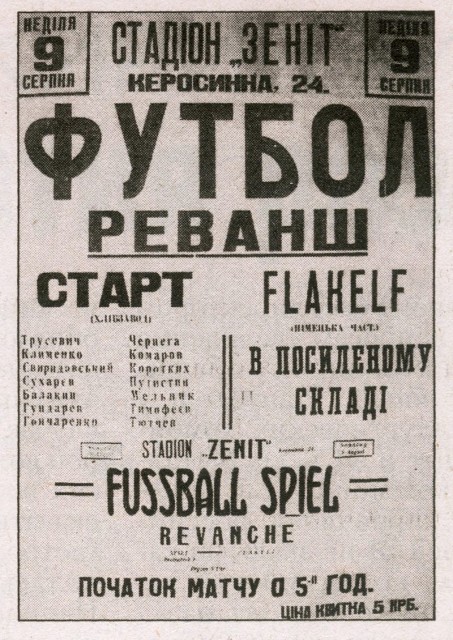
They decided to call them up for a rematch. Despite the excessive ticket price, some 2,000 spectators were present at the match. The stadium was allegedly surrounded by guards and dogs. The Nazi government was already becoming a laughing stock of Kyiv, despite their cruelty.
As the match kicked off, the referee who was a Nazi officer, neglected the rough play of his team, which resulted in landing the goalkeeper of FC Start unconscious. By some oral testimonies, the Flakelf used this time to score three goals. When the goalkeeper came back to his senses, the team fought back, winning the game with the result 5:3.
In the months after the match players were arrested on various charges, most of them concerning the accusation that they were NKVD agents, as the relation between the Soviet secret police and the football clubs existed before the war. Subsequently, five of them died in the next few months.
Now comes the veil of mystery. More than a year later, in 1943, Kyiv was liberated by the Red Army. Once the Soviets learned about the football tournament, they were weary of promoting it in fear that the FC Start members were in some way collaborationists. But, since the story was already out there, they used it for their own gain, distorting it so it would sound more romantic.
One of the original team members, Makar Goncharenko, was allegedly instructed to say that the Gestapo threatened the players to either lose the game or lose their lives. Apart from that, several eyewitnesses have confirmed in 1992, that the match wasn’t as heavily guarded as the Soviets later said it was and that the red jerseys were distributed by the Germans, so there was no place for a deliberate subversion.
Nevertheless, the most important question remains ― were the five football players ― Olexander Tkachenko, Mikola Korotkykh, Nikolai Trusevich, Olexi Klimenko and Ivan Kuzmenko ― murdered because of their involvement in the devastating defeat of the Flakelf team?
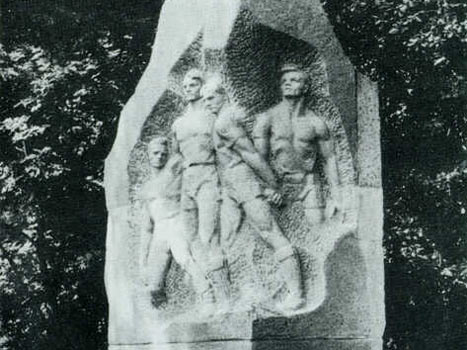
The Soviet version of the story, backed by some modern historians, claims so, but in 2005, a court in Hamburg dismissed the notion, after an investigation. The investigation concluded several reasons for which the arrested players were shot, none of them being connected to the match.
Nevertheless, the idea that the players defeated their enemy on the football field and paid dearly remains a source of pride and inspiration as the monument dedicated to the fallen FC Start members stands in Kyiv to this day.
Besides the monument, there are film depictions of the event, most famous being the 1981 Escape to Victory, directed by John Huston and set in a POW camp in France.
